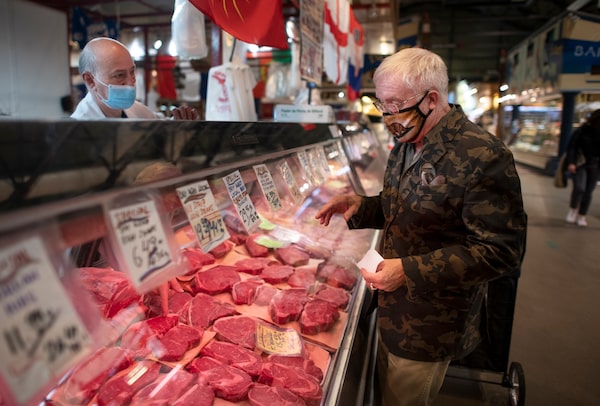
Nelson Joannette right, shops for steaks in the St. Lawrence Markets on Nov 17. Canada's 12-month inflation rate held essentially steady in November, at 4.7 per cent; taken to a second decimal place (4.72 per cent), it represented the highest inflation rate in 30 years.Fred Lum/The Globe and Mail
Canada’s inflation headlines may have reached their zenith. Now comes the kind of inflation we really have to worry about.
The issue from here will be not how high inflation gets, but how wide. The more it seeps beyond a few high-profile goods and into the broader economy, the more problematic it becomes.
Wednesday’s monthly consumer price index (CPI) report showed signs both that the inflation surge may have peaked, and that this broadening may be taking hold.
The 12-month inflation rate held essentially steady in November, at 4.7 per cent. Taken to a second decimal place (4.72 per cent), it represented the highest inflation rate in 30 years – a fact that quickly found its way into headlines.
Still, the month-to-month increase was a relatively modest 0.2 per cent, matching the slowest pace since last December. The single biggest source of inflation – gasoline prices, up a staggering 44 per cent from a year earlier – actually retreated slightly from October. Pump price data indicate gasoline has fallen considerably further since then. Just by looking at year-ago prices, we know that those alarming year-over-year comparisons are due to tame a lot over the next few months.
Bank of Canada renews 2-per-cent inflation target, emphasizes maximum employment
Against inflation risk, Bank of Canada must ruffle feathers and act early
And if you exclude energy and food costs – the two components of inflation that are prone to sharp price swings, both up and down – November inflation for the rest of the consumer price index was 3.1 per cent, just a hair above the top end of the Bank of Canada’s 1-per-cent to 3-per-cent comfort range.
Granted, it’s pretty hard for the average household to just shrug and say, “Oh, food and energy, just ignore them.” But the reality is that much of this year’s startling inflation run has been confined to a pretty narrow, if high-profile, range of products.
In a report published this week by the Canadian Centre for Policy Alternatives, economist David Macdonald calculated that in October, just six out of the roughly 200 item categories in the CPI (gasoline, natural gas, home heating oil, housing, automobiles and meat) accounted for more than half of that month’s 4.7-per-cent inflation. The rest of the consumer goods in the index ran at a very normal 2.25 per cent.
But there were hints in the November report that inflation is starting to become more entrenched beyond this narrow band of problem goods.
Perhaps the most significant and influential evidence emerged in one of the Bank of Canada’s three measures of core inflation – gauges that are designed to filter through short-term volatility and item-specific spikes, to give a view of the broader inflation pressures underneath.
The measure in question, known as CPI-common, uses an elaborate statistical model to measure only the proportion of inflation that is common to all items across the entire consumer price index.
A few years ago, when the central bank was looking at improved ways to measure core inflation, it was clear that the bank was particularly fond of the CPI-common. Of the three gauges that the bank uses, many consider the CPI-common to be the measure most sensitive to the economy approaching full capacity – and thus a critical signal for when the bank would raise interest rates.
CPI-common has been remarkably tame throughout this year’s inflation surge, tracking well below 2 per cent even as the bank’s two other core measures hovered near 3 per cent. But in November, it hit the bank’s 2-per-cent inflation target for the first time in more than three years.
For the Bank of Canada – whose inflation-fighting mandate was reaffirmed by the federal government just this week – that signal is going to be pretty hard to ignore.
Other careful analyses of the inflation data have begun to show this broadening of price pressures. Economist Claire Fan of Royal Bank of Canada said in a report Wednesday that if you look at price increases since before the COVID-19 pandemic, 58 per cent of items in the CPI are now up at an annual rate of more than the Bank of Canada’s 2-per-cent target, based on three-month average prices. That’s up from 54 per cent just four months ago.
This increasingly visible broadening of inflation reflects a couple of things. One, that second-stage effects of inflation are starting to show up as this year’s price spikes have lingered, in the form of rising wage demands that have begun to get passed along to consumers. And two, that the economy is, indeed, closing in on full capacity.
Both of those factors matter a great deal to the Bank of Canada, as it moves closer to starting to raise interest rates next year.
“I think what you’re seeing overall is that the significant amount of slack that we did have in the economy is substantially diminished,” Bank of Canada governor Tiff Macklem said in a news conference following a speech Wednesday.
Even more telling was this response to an audience question on inflation following his speech:
“We are not comfortable where we are,” he said.
That one short sentence speaks volumes. When the Bank of Canada is uncomfortable, it can only stay that way for so long before taking action. If inflation continues to broaden, that action – interest-rate increases – will become increasingly urgent.
Your time is valuable. Have the Top Business Headlines newsletter conveniently delivered to your inbox in the morning or evening. Sign up today.
 David Parkinson
David Parkinson